Jules Jay, from Hurstbridge, is a permaculture enthusiast who is a leading light in North East Region Permaculture. This article is about how to make milk kefir at home. To start off, you will need to obtain some kefir grains. You can buy these online or source them from another local kefir maker. A call for grains on a local free goods page will often reveal some.
The steps below describe the whole process as if you’ve been making kefir for a while. But if you’re starting with new kefir grains, the first few steps are not required. More specifically:
- If you received your grains dry, jump to step 5.
- If you received your grains in milk, jump to step 3 (straining).
- If your grains have been frozen in milk powder, you’ll need to rinse them off with a little milk and then proceed to step 3 (straining).
Of course, once you’ve made your first batch, you’ll follow the whole process from the beginning to make subsequent batches.
|
What you’ll need:
- Current kefir batch (or 1 tablespoon fresh grains that you’ve been given).
- Plastic or glass bowl.
- Mesh sieve.
- Spoon.
- Clean bottle with lid.
- Cloth cover with rubber band.
- 1 or 2 cups of milk.
|
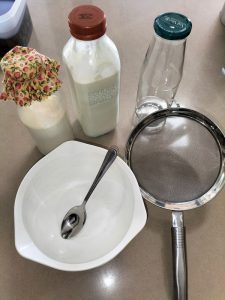 |
|
1. I start with my current brew, which has been fermenting in the cupboard for a day or two. It has a cloth lid on it so it can breathe, held on with a rubber band.
The kefir needs to be strained to separate the liquid from the kefir grains. Before straining, I put a solid lid on the bottle and give it a shake to mix everything up. This helps if the kefir is a tad over-fermented and has become quick thick.
|
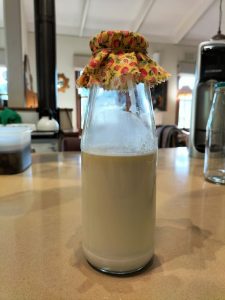 |
|
2. Once the kefir has been shaken, remove the lid and strain the mix through a mesh strainer into a plastic bowl.
Kefir is acidic and can react with metals so it’s best to use plastic, glass or stainless steel equipment when making it. That said, short-term contact with metal probably won’t be a big deal.
|
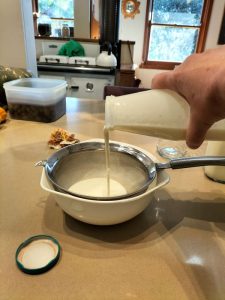 |
|
3. When the liquid has drained, you should be left with the kefir grains in the strainer and with the finished kefir drink in the bowl.
If the kefir is really thick, you may need to use a spoon to stir and scrape the mix to separate it from the grains. Don’t be shy: the grains are gelatinous, super tough and won’t be harmed by a bit of elbow grease.
|
 |
|
4. When the milk is drained, all that should be left in the strainer are your perpetual kefir grains which you’ll use for the next batch.
|
 |
|
5. Remove your grains from the strainer and tip them into a clean jar.
Note that kefir grains are living organisms that grow and multiply when you feed them lactose. If they’ve multiplied to be more than you need, take some out at this stage and freeze them as spares. I’ll tell you how to do this at the end.
|
 |
|
6. Meanwhile, take the strained and finished kefir in the bowl and pour it back into the jar it came from. If you’re less lazy than me you could pour it into a clean jar, but to my mind that’s just an extra thing to wash.
Put the solid lid back on the jar. This lot is now ready to use.
|
 |
|
7. If you’ve done things right, you should now have your finished kefir that you’ve strained and returned to the bottle (the lefthand bottle in the photo), and a clean jar with grains in it for your new batch (the righthand bottle in the photo).
If you haven’t done it right, you’ve probably tipped your finished kefir back onto your grains and you’ll need to strain everything again.
Your finished jar of kefir can now go into the fridge for chilling. This is ready to drink as is, or to use in smoothies, etc.
|
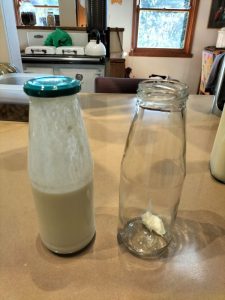 |
|
8. To make your next batch for fermenting, just add milk to your clean jar with the grains in it.
Unfortunately there’s no hard and fast rule about grain to milk ratios. Rather, it’s largely trial and error depending on the vitality of your grains, the type of milk you’re using, the weather, and how thick and tangy you like your kefir. Like all ferments, heat is a major factor, as kefir ferments way more quickly in warm temperatures than it does in cool. (Summer combined with a warm house makes for a lot of kefir smoothies.)
You could start with a tablespoon of grains in a cup or so of milk and experiment to find the right duration of ferment and ratio of grains to milk for you.
|
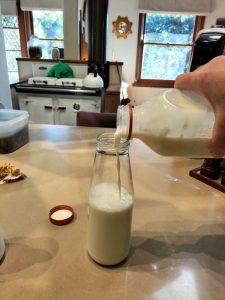 |
|
9. Place the cloth top on the jar with the grains, and secure with a rubber band.
|
 |
|
10. Place the new fermenting batch in a dark spot like a cupboard, and wait for it to work its lactobacillus magic.
I don’t shake mine during fermentation as it ferments quickly. But if your brew is a tad sluggish, the process can be sped along by stirring or shaking the mix a couple of times a day. (Take the cloth off and put a solid lid on it first.)
Once it’s fermented, start from the beginning to make a new batch.
|
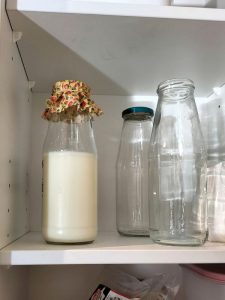 |












Hi Jules
Your information on making kefir was excellent. I used to make kefir a few years ago and would like to start again. I live in Mernda. Do you know anyone not to far away who would have some grains for sale or maybe you would be able to supply me with some? Hoping you can help me.
Dorothy
Hi Dorothy
Thanks for the lovely comment. I’m in Hurstbridge and have loads of spare grains. You can text or call me on 0400 750 750 to organise pick up if you’d like some.